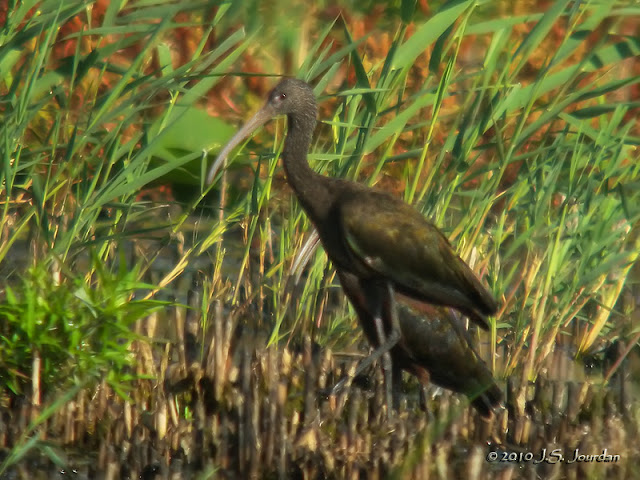Whimbrel - 17 Jul 2010
I stopped near the pump house just long enough to grab a couple of photos of the American Lotus that was growing and blooming in Mouillee Creek. I bypassed several digiscoping opportunities (Bank Swallows, Indigo Buntings) and headed directly to the Vermet Unit where I found Will just beyond the crop field.
The ibises were in view approximately 100-120' away and at the edge of any useful digiscoping opportunities. Will provided a terrific writeup on his blog site with observations and photos regarding the suspected hybridization (Glossy X White-faced) of at least one of the birds. I managed a couple of keepers, but the rising temperatures and moisture in the air produced a lot of distortion. Still, I could make out the red eyes on the smaller of the two birds and the brown eyes on the (presumed) pure Glossy ibis.
No sooner did we head for the Banana Unit that a Whimbrel flushed from the crop field to our left. I managed a couple of flight shots as it took off just a few feet away and we watched it land in the road ~150' ahead of us. We scoped the bird as it fed on bees and walked briskly away and then followed it toward the Banana Unit where it flushed again and flew back to our left and landed back in the crop field.
We were disappointed to find that Cell 3 was completely submerged under water with only a tiny spit of mud occupied by Ring-billed/Herring Gulls and a few Caspian Terns. Unless the water is drawn down there'll be no habitat available for migrating shorebirds. I stopped on the way out to photograph a few of the many Blue Dasher dragonflies hovering and resting on the numerous knapweed plants lining the dike. One photo was even sharp enough to resolve individual eyeballs of the compound eye.
Several Black Swallowtail butterflies were nearby, as well. I was able to grab numerous photos of one cooperative bug. Cabbage Whites were numerous, but none would light onto plants for pics.
We scoped the Humphries (Lead) Unit but found nothing of interest. The Vermet Unit held several large concentrations of Great Blue Herons / Great Egrets, but little in the way of shorebirds (other than a few Lesser Yellowlegs and a Solitary Sandpiper).
Returning to the Middle Causeway via the Vermet/Long Pond trail we saw a few Indigo Buntings, Least Sandpipers and Killdeer, but nothing worth stopping for. We returned to the cars at 11:30 am as the winds and heat picked up.
Pte. Mouillee SGA (permit required Sep 1-Dec 15), Monroe, Michigan, US
Jul 17, 2010 9:00 AM - 11:30 AM
Protocol: Traveling
5.0 mile(s)
13 species (+1 other taxa)
Killdeer (Charadrius vociferus) 2
Whimbrel (Numenius phaeopus) 1 Middle Causeway at Banana Unit. Flushed. Photographed in flight and on ground. Large brown shorebird w/ crown stripes and long decurved bill.
Solitary Sandpiper (Tringa solitaria) 1
Lesser Yellowlegs (Tringa flavipes) 2
Least Sandpiper (Calidris minutilla) 2
Ring-billed Gull (Larus delawarensis) 16
Herring Gull (Larus argentatus) 10
Caspian Tern (Hydroprogne caspia) 8
Great Egret (Ardea alba) 30
Great Blue Heron (Ardea herodias) 6
Glossy/White-faced Ibis (Plegadis falcinellus/chihi) 3 Middle Causeway at west end of soybean field next to Vermet. 3 dark brown ibises. Two showing molt in primaries, one shows brown eyes and is suspected Glossy Ibis while the other had red eyes and is suspected hybrid. State rare bird reports were submitted.
Bank Swallow (Riparia riparia) 12
Tree Swallow (Tachycineta bicolor) 12
Indigo Bunting (Passerina cyanea) 3
View this checklist online at https://ebird.org/checklist/S1
This report was generated automatically by eBird v3 (https://ebird.org/home)





















Love the first picture, GREAT image!!
ReplyDeleteJerry,
ReplyDeleteCool that you found the Whimbrel walking on the dike.
Cathy
O My goodness..all the photos are great!
ReplyDeleteThe Blue DAsher!!! wow.
Going to tweet this out to the twitterverse.